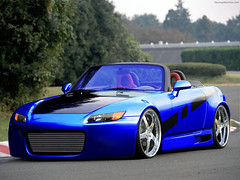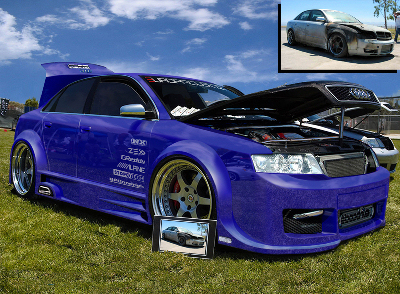
Toyota debuted the new Prius (2010 US model year) at the 2009 North American International Auto Show, and sales began in Japan on May 18, 2009. Its new body design is more aerodynamic, with the coefficient of drag reduced to 0.25 Cd. An underbody rear fin helps stabilize the vehicle at higher speeds.
The estimated fuel-efficiency rating using the U.S. EPA combined cycle is: 50 mpg-US (4.7 L/100 km; 60 mpg-imp).[52] The Prius becomes the most efficient car powered by liquid fuel available in the U.S. in 2009, based on the official rating. Only the first-generation Honda Insight (2000–2006) equipped with a manual transmission attained higher mileage. The official UK fuel efficiency data for the Prius T3 is: Urban 72.4 mpg-imp (3.90 L/100 km; 60.3 mpg-US), Extra Urban 76.4 mpg-imp (3.70 L/100 km; 63.6 mpg-US), Combined 72.4 mpg-imp (3.90 L/100 km; 60.3 mpg-US).
The 1.8-liter gasoline engine (previously 1.5 liters) generates 98 hp, and with the added power of the electric motor, total horsepower is 134 hp (previously 110 hp). The larger engine displacement allows for increased torque, reducing engine speeds (RPM) which in turn increases fuel economy at highway speeds. With an electric water pump, the Prius engine is the first production engine that requires no accessory belts, which also further improves fuel economy. The electric motors and other components of the hybrid powertrain are also smaller and more efficient. Toyota estimates the new inverter, motor and transaxle are 20 percent lighter. Disc brakes replace the previous rear drum brakes.
Interior
For the Prius, Toyota used a new range of plant-derived ecological bioplastics made from the cellulose in wood or grass instead of petroleum. The two principal crops are kenaf (a member of the hibiscus family and related to cotton and okra) and ramie, commonly known as China grass and one of the strongest natural fibres, similar to flax in absorbency and density. Toyota says this is a particularly timely breakthrough for plant-based eco-plastics because 2009 is the United Nations’ International Year of Natural Fibres, which covers kenaf and ramie.[56]
In Japan, it is reported that Toyota cut the price of Prius from 2.331 million yen to 2.05 million yen to compete with Honda Insight. Toyota filed over one thousand patents during the development of the latest Prius. Toyota's goal is to sell about 400,000 units annually around the globe and 180,000 units in the U.S. by 2010. In May 2009 production was increased to 50,000 units per month or 600,000 annual units to help meet higher than projected demand. In 2009, Toyota Prius experienced two consecutive year over year sales decrease to 139,682 units in the U.S., from 181,221 units in 2007.[61] In addition, Toyota Prius was launched in Malaysia on August 4, 2009. In early 2010, Toyota considered to add a monthly production of 6,000 at the Motomachi factory, in central Japan, the plant that built the first-generation Prius which was launched in 1997. However, as customers' wait time in Japan shortened from eight months at launch to three months and sales in the United States dropped 40 percent in February 2010 from that of October 2009 following concerns about Toyota vehicles' safety, Toyota had to reduce the monthly production by 10 percent to 45,000 units a month in March 2010.
In the US the Prius will have a starting base price of US$22,400 excluding destination charges, and includes 15-inch alloy wheels, Vehicle Stability Control and interior amenities including cruise control, 6-speaker audio, Toyota's keyless entry/ignition Smart Key System and a unique Touch Tracer Display designed to help the driver's eyes stay on the road when using the steering-wheel-mounted climate and audio controls.
2009 Toyota Prius (Australia)
Sales of the Prius also started in the Philippines on June 22, 2009, for a SRP of Php 2.2 million (approximately US$41,800) about half for import duties and other taxes, making it the first hybrid vehicle available in the Philippines. The launching for the Latin American market took place in Costa Rica on July 3, 2009. The Prius will be sold in Costa Rica for US$41,000 including tariffs and all taxes.
The US Prius will offer three optional packages:
A Navigation Package which includes a voice-activated touch-screen DVD-based navigation system and an 8-speaker JBL audio system with XM satellite radio, MP3/WMA playback capability, Bluetooth and backup camera. The Prius in Japan is equipped with G-BOOK as of May 18, 2009.
The estimated fuel-efficiency rating using the U.S. EPA combined cycle is: 50 mpg-US (4.7 L/100 km; 60 mpg-imp).[52] The Prius becomes the most efficient car powered by liquid fuel available in the U.S. in 2009, based on the official rating. Only the first-generation Honda Insight (2000–2006) equipped with a manual transmission attained higher mileage. The official UK fuel efficiency data for the Prius T3 is: Urban 72.4 mpg-imp (3.90 L/100 km; 60.3 mpg-US), Extra Urban 76.4 mpg-imp (3.70 L/100 km; 63.6 mpg-US), Combined 72.4 mpg-imp (3.90 L/100 km; 60.3 mpg-US).
The 1.8-liter gasoline engine (previously 1.5 liters) generates 98 hp, and with the added power of the electric motor, total horsepower is 134 hp (previously 110 hp). The larger engine displacement allows for increased torque, reducing engine speeds (RPM) which in turn increases fuel economy at highway speeds. With an electric water pump, the Prius engine is the first production engine that requires no accessory belts, which also further improves fuel economy. The electric motors and other components of the hybrid powertrain are also smaller and more efficient. Toyota estimates the new inverter, motor and transaxle are 20 percent lighter. Disc brakes replace the previous rear drum brakes.
Interior
For the Prius, Toyota used a new range of plant-derived ecological bioplastics made from the cellulose in wood or grass instead of petroleum. The two principal crops are kenaf (a member of the hibiscus family and related to cotton and okra) and ramie, commonly known as China grass and one of the strongest natural fibres, similar to flax in absorbency and density. Toyota says this is a particularly timely breakthrough for plant-based eco-plastics because 2009 is the United Nations’ International Year of Natural Fibres, which covers kenaf and ramie.[56]
In Japan, it is reported that Toyota cut the price of Prius from 2.331 million yen to 2.05 million yen to compete with Honda Insight. Toyota filed over one thousand patents during the development of the latest Prius. Toyota's goal is to sell about 400,000 units annually around the globe and 180,000 units in the U.S. by 2010. In May 2009 production was increased to 50,000 units per month or 600,000 annual units to help meet higher than projected demand. In 2009, Toyota Prius experienced two consecutive year over year sales decrease to 139,682 units in the U.S., from 181,221 units in 2007.[61] In addition, Toyota Prius was launched in Malaysia on August 4, 2009. In early 2010, Toyota considered to add a monthly production of 6,000 at the Motomachi factory, in central Japan, the plant that built the first-generation Prius which was launched in 1997. However, as customers' wait time in Japan shortened from eight months at launch to three months and sales in the United States dropped 40 percent in February 2010 from that of October 2009 following concerns about Toyota vehicles' safety, Toyota had to reduce the monthly production by 10 percent to 45,000 units a month in March 2010.
In the US the Prius will have a starting base price of US$22,400 excluding destination charges, and includes 15-inch alloy wheels, Vehicle Stability Control and interior amenities including cruise control, 6-speaker audio, Toyota's keyless entry/ignition Smart Key System and a unique Touch Tracer Display designed to help the driver's eyes stay on the road when using the steering-wheel-mounted climate and audio controls.
2009 Toyota Prius (Australia)
Sales of the Prius also started in the Philippines on June 22, 2009, for a SRP of Php 2.2 million (approximately US$41,800) about half for import duties and other taxes, making it the first hybrid vehicle available in the Philippines. The launching for the Latin American market took place in Costa Rica on July 3, 2009. The Prius will be sold in Costa Rica for US$41,000 including tariffs and all taxes.
The US Prius will offer three optional packages:
A Navigation Package which includes a voice-activated touch-screen DVD-based navigation system and an 8-speaker JBL audio system with XM satellite radio, MP3/WMA playback capability, Bluetooth and backup camera. The Prius in Japan is equipped with G-BOOK as of May 18, 2009.
A Solar Roof Package includes the Navigation Package and adds a power tilt/slide moonroof along with a solar powered ventilation system which uses an electric fan to help keep the vehicle cooler when parked under the sun by venting the interior's heated air with the outdoors. The solar roof was originally intended to assist in charging the vehicle's battery, but the system was configured to only power ventilation when it was found that the battery-charging configuration created electromagnetic interference that affected the radio. A new remote air-conditioning feature allows the driver to activate the air conditioner prior to entering the vehicle.
An Advanced Technology Package includes the Navigation Package while adding a Pre-Collision System, Dynamic Radar Cruise Control, Lane Keep Assist and Intelligent Parking Assist.
An Advanced Technology Package includes the Navigation Package while adding a Pre-Collision System, Dynamic Radar Cruise Control, Lane Keep Assist and Intelligent Parking Assist.

















No comments:
Post a Comment